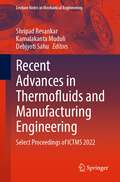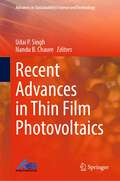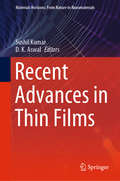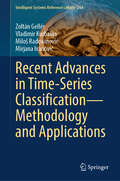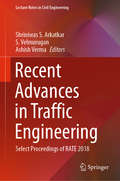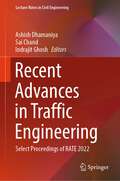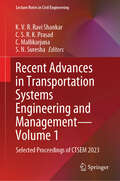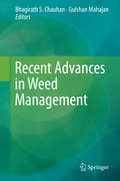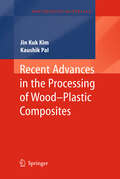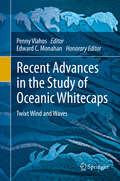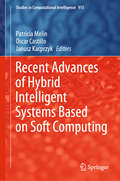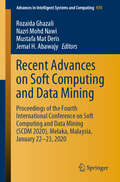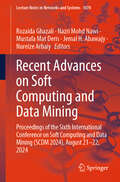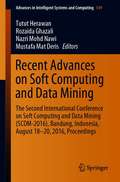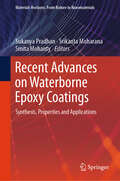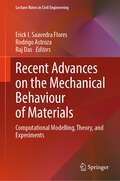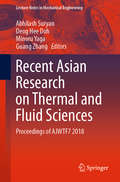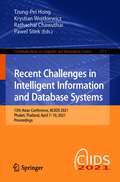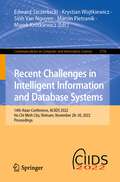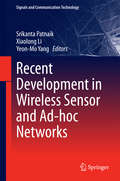- Table View
- List View
Recent Advances in Thermal Sciences and Engineering: Select Proceedings of ICAFFTS 2021 (Lecture Notes in Mechanical Engineering)
by Hemant B. Mehta Manish K. Rathod Rufat Abiev Müslüm ArıcıThis book presents select proceedings of the International Conference on Advances in Fluid Flow and Thermal Sciences (ICAFFTS 2021) and summarizes the modern research practices in thermal sciences and engineering. The content of book involves advanced topics in heat transfer science, automobile, refrigeration and air conditioning, cryogenics, non-conventional systems and energy storage. Topics on cutting edge research in the area of hybrid nano-PCM-based systems, solar-based applications, bio-diesel and nano additives-based combustion, fuel cell and thermoacoustic engine are also included. In addition, this book contains recent research in the area of two-phase thermal management of Li-Ion/Li-titanium battery and LED systems using heat sink, heat pipe, pulsating heat pipe and thermosyphon with next-generation refrigerants, PCM and nanofluid. Some thermal aspects of virus/aerosol research, advances in volumetric velocimetry and application of artificial intelligence in thermal systems are also covered. This book is a valuable reference for academicians, researchers and professionals working in the various fields of thermal sciences.
Recent Advances in Thermofluids and Manufacturing Engineering: Select Proceedings of ICTMS 2022 (Lecture Notes in Mechanical Engineering)
by Shripad Revankar Debjyoti Sahu Kamalakanta MuduliThis book presents the select proceedings of the International Conference on Thermofluids and Manufacturing Science (ICTMS 2022). Some of the topics covered include Heat transfer, fluid dynamics, multiphase flow, flow diagnostics using artificial neural network, aerodynamics, high-speed flows, sustainable energy technology, propulsion and emissions, Eco-friendly manufacturing, Coating Techniques and Supply chain management etc. Given the scope, the book will be highly useful for researchers and professionals interested in mechanical, production or aerospace engineering
Recent Advances in Thin Film Photovoltaics (Advances in Sustainability Science and Technology)
by Udai P. Singh Nandu B. ChaureThis book provides recent development in thin-film solar cells (TFSC). TFSC have proven the promising approach for terrestrial and space photovoltaics. TFSC have the potential to change the device design and produce high efficiency devices on rigid/flexible substrates with significantly low manufacturing cost. TFSC have several advantages in manufacturing compared to traditional crystalline Si-solar cells like less requirement of materials, can be prepared with earth’s abundant materials, less processing steps, easy to dispose, etc. Several universities/research institutes/industry in India and abroad are involved in the research area of thin-film solar cells. The book helps the readers to find the details about different thin-film technologies and its advancement at one place. Each chapter covers properties of materials, its suitability for PV applications, simple manufacturing processes and recent and past literature survey. The issues related to the development of high efficiency TFSC devices over large area and its commercial and future prospects are discussed.
Recent Advances in Thin Films (Materials Horizons: From Nature to Nanomaterials)
by Sushil Kumar D. K. AswalThis volume comprises the expert contributions from the invited speakers at the 17th International Conference on Thin Films (ICTF 2017), held at CSIR-NPL, New Delhi, India. Thin film research has become increasingly important over the last few decades owing to the applications in latest technologies and devices. The book focuses on current advances in thin film deposition processes and characterization including thin film measurements. The chapters cover different types of thin films like metal, dielectric, organic and inorganic, and their diverse applications across transistors, resistors, capacitors, memory elements for computers, optical filters and mirrors, sensors, solar cells, LED's, transparent conducting coatings for liquid crystal display, printed circuit board, and automobile headlamp covers. This book can be a useful reference for students, researchers as well as industry professionals by providing an up-to-date knowledge on thin films and coatings.
Recent Advances in Time-Series Classification—Methodology and Applications (Intelligent Systems Reference Library #264)
by Mirjana Ivanović Miloš Radovanović Zoltán Gellér Vladimir KurbalijaThis book examines the impact of such constraints on elastic time-series similarity measures and provides guidance on selecting suitable measures. Time-series classification frequently relies on selecting an appropriate similarity or distance measure to compare time series effectively, often using dynamic programming techniques for more robust results. However, these techniques can be computationally demanding, which results in the usage of global constraints to reduce the search area in the dynamic programming matrix. While these constraints cut computation time significantly (by up to three orders of magnitude), they may also affect classification accuracy. Additionally, the importance of the nearest neighbor classifier (1NN) is emphasized for its strong performance in time-series classification, alongside the kNN classifier which offers stable results. This book further explores the weighted kNN classifier, which gives closer neighbors more influence, showing how it merges accuracy and stability for improved classification outcomes.
Recent Advances in Traffic Engineering: Select Proceedings of RATE 2018 (Lecture Notes in Civil Engineering #69)
by Ashish Verma Shriniwas S. Arkatkar S. VelmuruganThis book comprises select proceedings of the National Conference on Recent Advances in Traffic Engineering (RATE 2018) with technical papers on the themes of traffic operation control and management, traffic safety and vulnerable road users, and sustainable transportation. It covers a wide range of topics, including advanced traffic data collection methods, big data analysis, mix-traffic characterization and modelling, travel time reliability, scenario of pedestrian and non-motorised vehicles (NMVs) traffic, regional traffic growth modelling, and applications of intelligent transportation systems (ITS) in traffic management. The contents of this book offer up-to-date and practical knowledge on different aspects of traffic engineering, which is useful for students, researchers as well as practitioners.
Recent Advances in Traffic Engineering: Select Proceedings of RATE 2022 (Lecture Notes in Civil Engineering #377)
by Indrajit Ghosh Ashish Dhamaniya Sai ChandThis book comprises select peer-reviewed proceedings of the National Conference on Recent Advances in Traffic Engineering (RATE 2022). The contents includes in-depth insights into the domain of traffic engineering and planning and presents the latest advancements by focusing on traffic engineering, traffic flow, road safety, advanced techniques for transportation surveys, and data collection. It covers topics including travel demand modeling and transportation planning issues. The contents of this book offer up-to-date and practical knowledge on different aspects of traffic engineering. It will be useful for researchers as well as practitioners.
Recent Advances in Transportation Systems Engineering and Management: Select Proceedings of CTSEM 2021 (Lecture Notes in Civil Engineering #261)
by Shriniwas S. Arkatkar M. V. L. R. Anjaneyulu M. Harikrishna A. VeeraragavanThe book presents the select proceedings of the 8th International Conference on Transportation Systems Engineering and Management (CTSEM 2021). The book covers topics pertaining to three broad areas of transportation engineering, namely Transportation Planning, Traffic Engineering and Pavement Technology. The topics covered include transportation and land use, urban and regional transportation planning, travel behavior modeling, travel demand analysis, forecasting and management, transportation and ICT, public transport planning and management, freight transport, traffic flow modeling and management, highway design and maintenance, capacity and level of service, traffic crashes and safety, ITS and applications, non-motorized transportation, transportation economics and policy, road and parking pricing, pedestrian facilities and safety, road asset management, pavement materials and characterization, pavement design and construction, pavement evaluation and management, transportation infrastructure financing, innovative trends in transportation systems, sustainable transportation, smart cities, resilience of transportation systems and environmental and ecological aspects. This book will be useful for the students, researchers and the professionals in the area of civil engineering, especially transportation and traffic engineering.
Recent Advances in Transportation Systems Engineering and Management—Volume 1: Selected Proceedings of CTSEM 2023 (Lecture Notes in Civil Engineering #544)
by K. V. R. Ravi Shankar C. S. R. K. Prasad C. Mallikarjuna S. N. SureshaThe book presents select proceedings of the 9th Conference on Transportation Systems Engineering and Management (CTSEM 2023). It broadly covers areas of transportation engineering, namely traffic engineering and safety, transportation planning and pavement engineering. In particular, the book delves into the current research in specific areas including but not limited to intelligent transportation systems and applications, public transport planning and management, urban and regional transportation planning, freight transport and logistics, traffic flow modeling and management, highway design and maintenance, pavement materials and characterization, accident investigations and crash preventive measures, pedestrian facilities and safety, pavement design and construction, pavement evaluation and management, and sustainable transportation. It also sheds light on topics like Artificial Intelligence (AI), big data and the Internet of Things (IoT), and their application in transportation systems. This book will be a valuable resource for researchers and professionals in transportation engineering and civil engineering.
Recent Advances in Transportation Systems Engineering and Management—Volume 2: Selected Proceedings of CTSEM 2023 (Lecture Notes in Civil Engineering #545)
by C. Mallikarjuna S. N. Suresha K.V.R. Ravi Shankar C.S.R.K. PrasadThe book presents select proceedings of the 9th Conference on Transportation Systems Engineering and Management (CTSEM 2023). It broadly covers areas of transportation engineering, namely traffic engineering and safety, transportation planning and pavement engineering. In particular, the book delves into the current research in specific areas including but not limited to intelligent transportation systems and applications, public transport planning and management, urban and regional transportation planning, freight transport and logistics, traffic flow modeling and management, highway design and maintenance, pavement materials and characterization, accident investigations and crash preventive measures, pedestrian facilities and safety, pavement design and construction, pavement evaluation and management, and sustainable transportation. It also sheds light on topics like Artificial Intelligence (AI), big data and the Internet of Things (IoT), and their application in transportation systems. This book will be a valuable resource for researchers and professionals in transportation engineering and civil engineering.
Recent Advances in Weed Management
by Bhagirath S. Chauhan Gulshan MahajanThis volume addresses recent developments in weed science. These developments include conservation agriculture and conservation tillage, climate change, environmental concerns about the runoff of agrochemicals, resistance of weeds and crops to herbicides, and the need for a vastly improved understanding of weed ecology and herbicide use. The book provides details on harnessing knowledge of weed ecology to improve weed management in different crops and presents information on opportunities in weed management in different crops. Current management practices are also covered, along with guidance for selecting herbicides and using them effectively. Written by experts in the field and supplemented with instructive illustrations and tables, Recent Advances in Weed Management is an essential reference for agricultural specialists and researchers, government agents, extension specialists, and professionals throughout the agrochemical industry, as well as a foundation for advanced students taking courses in weed science.
Recent Advances in the Processing of Wood-Plastic Composites
by Jin Kuk Kim Kaushik PalWood-plastic composite (WPC) is a non-recyclable composite material lumber or timber made of recycled plastic and wood wastes which has become one of the most dynamic sectors of the plastics industry in this decade. It is used in numerous applications, such as, outdoor deck floors, railings, fences, landscaping timbers, park benches, window and door frames. This book starts with a brief glimpse at the basic structures and properties of WPCs. Aspects such as surface treatment, machinery used and testing types of WPCs are also covered. The following chapters of the book give a view of foam technology, flame retardant properties and colour retardant properties of WPCs. The way morphology affects or controls the physical and mechanical behaviours of the finished materials is discussed. Finally, the authors give an overview of the applications of wood-plastic composites in daily life. The book may serve as a source book for scientists wishing to work in this field.
Recent Advances in the Study of Oceanic Whitecaps: Twixt Wind and Waves
by Penny Vlahos Edward C. MonahanThis book provides the reader with the a comprehensive summary of the recent advances in the study of whitecaps. It is the first major publication focusing specifically on whitecaps and their role in a variety of climate-relevant air-sea interaction processes since the publication, in 1986, of Oceanic Whitecaps, and Their Role in Air-Sea Exchange Processes, edited by Edward Charles Monahan and Gearoid Mac Niocaill (published by Springer). This book also provides the interested reader with a review of the initial work done on this topic in the second half of the 20th Century.
Recent Advances of Hybrid Intelligent Systems Based on Soft Computing (Studies in Computational Intelligence #915)
by Oscar Castillo Patricia Melin Janusz KacprzykThis book describes recent advances on fuzzy logic, neural networks and optimization algorithms, as well as their hybrid combinations, and their application in areas such as intelligent control and robotics, pattern recognition, medical diagnosis, time series prediction and optimization of complex problems. The book contains a collection of papers focused on hybrid intelligent systems based on soft computing. There are some papers with the main theme of type-1 and type-2 fuzzy logic, which basically consists of papers that propose new concepts and algorithms based on type-1 and type-2 fuzzy logic and their applications. There are also some papers that present theory and practice of meta-heuristics in different areas of application. Another group of papers describes diverse applications of fuzzy logic, neural networks and hybrid intelligent systems in medical applications. There are also some papers that present theory and practice of neural networks in different areas of application. In addition, there are papers that present theory and practice of optimization and evolutionary algorithms in different areas of application. Finally, there are some papers describing applications of fuzzy logic, neural networks and meta-heuristics in pattern recognition problems.
Recent Advances on Memetic Algorithms and its Applications in Image Processing (Studies in Computational Intelligence #873)
by D. Jude Hemanth B. Vinoth Kumar G. R. Karpagam ManavalanThis book includes original research findings in the field of memetic algorithms for image processing applications. It gathers contributions on theory, case studies, and design methods pertaining to memetic algorithms for image processing applications ranging from defence, medical image processing, and surveillance, to computer vision, robotics, etc. The content presented here provides new directions for future research from both theoretical and practical viewpoints, and will spur further advances in the field.
Recent Advances on Soft Computing and Data Mining: Proceedings of the Fourth International Conference on Soft Computing and Data Mining (SCDM 2020), Melaka, Malaysia, January 22–23, 2020 (Advances in Intelligent Systems and Computing #978)
by Jemal H. Abawajy Rozaida Ghazali Nazri Mohd Nawi Mustafa Mat DerisThis book provides an introduction to data science and offers a practical overview of the concepts and techniques that readers need to get the most out of their large-scale data mining projects and research studies. It discusses data-analytical thinking, which is essential to extract useful knowledge and obtain commercial value from the data. Also known as data-driven science, soft computing and data mining disciplines cover a broad interdisciplinary range of scientific methods and processes. The book provides readers with sufficient knowledge to tackle a wide range of issues in complex systems, bringing together the scopes that integrate soft computing and data mining in various combinations of applications and practices, since to thrive in these data-driven ecosystems, researchers, data analysts and practitioners must understand the design choice and options of these approaches. This book helps readers to solve complex benchmark problems and to better appreciate the concepts, tools and techniques used.
Recent Advances on Soft Computing and Data Mining: Proceedings of the Sixth International Conference on Soft Computing and Data Mining (SCDM 2024), August 21-22, 2024 (Lecture Notes in Networks and Systems #1078)
by Jemal H. Abawajy Rozaida Ghazali Nazri Mohd Nawi Mustafa Mat Deris Nureize ArbaiyThis book explores methods for leveraging data to create innovative solutions that offer significant and meaningful value. It provides practical insights into the concepts and techniques essential for maximizing the outcomes of large-scale research and data mining projects. Readers are guided through analytical thinking processes, addressing challenges in deciphering complex data systems and deriving commercial value from the data. Soft computing and data mining, also known as data-driven science, encompass a diverse range of interdisciplinary scientific methods and processes. The proceedings of "Recent Advances on Soft Computing and Data Mining" provide comprehensive knowledge to address various challenges encountered in complex systems. By integrating practices and applications from both domains, it offers a robust framework for tackling these issues. To excel in data-driven ecosystems, researchers, data analysts, and practitioners must carefully select the most suitable approaches and tools. Understanding the design choices and options available is essential for appreciating the underlying concepts, tools, and techniques utilized in these endeavors.
Recent Advances on Soft Computing and Data Mining: The Second International Conference on Soft Computing and Data Mining (SCDM-2016), Bandung, Indonesia, August 18-20, 2016 Proceedings (Advances in Intelligent Systems and Computing #549)
by Tutut Herawan Rozaida Ghazali Nazri Mohd Nawi Mustafa Mat DerisThis book provides a comprehensive introduction and practical look at the concepts and techniques readers need to get the most out of their data in real-world, large-scale data mining projects. It also guides readers through the data-analytic thinking necessary for extracting useful knowledge and business value from the data.The book is based on the Soft Computing and Data Mining (SCDM-16) conference, which was held in Bandung, Indonesia on August 18th–20th 2016 to discuss the state of the art in soft computing techniques, and offer participants sufficient knowledge to tackle a wide range of complex systems. The scope of the conference is reflected in the book, which presents a balance of soft computing techniques and data mining approaches. The two constituents are introduced to the reader systematically and brought together using different combinations of applications and practices. It offers engineers, data analysts, practitioners, scientists and managers the insights into the concepts, tools and techniques employed, and as such enables them to better understand the design choice and options of soft computing techniques and data mining approaches that are necessary to thrive in this data-driven ecosystem.
Recent Advances on Waterborne Epoxy Coatings: Synthesis, Properties and Applications (Materials Horizons: From Nature to Nanomaterials)
by Smita Mohanty Sukanya Pradhan Srikanta MoharanaThis book explains the fundamentals of waterborne coatings and current market trends that have an impact on the industry. The recent advancements in the field of waterborne epoxy coatings are thoroughly reviewed in the book. With special focus on the critical elements required to improve the properties of the system by the incorporation of various additives and their applications introduces the reader to the field's advancements while also explaining the applications, procedures, and synthesis and characterization techniques that are illustrated throughout. Insights into current research, trends, and issues are also hinted at. The book can be a valuable reference for researchers and professionals interested in waterborne epoxy coatings and allied fields.
Recent Advances on the Mechanical Behaviour of Materials: Computational Modelling, Theory, and Experiments (Lecture Notes in Civil Engineering #462)
by Rodrigo Astroza Raj Das Erick I. Saavedra FloresThis book is a collection of papers presented at the 14th International Conference on the Mechanical Behavior of Materials (ICM-14) held in Santiago, Chile, July 12–14, 2023. The mechanical properties of materials play a critical role in industrial and economic development. Advances in this field present significant challenges for current researchers in both industry and academia. The topics covered include mechanics of materials at the nano- and macro-scale, including metals, composites, ceramics, computational mechanics, dynamics, material processing, optimization, and biomechanics. The scope of materials of interest includes both industrial materials and those under development or used in specific applications. Some specific subjects include general mechanical behavior and constitutive models, mathematical modeling of materials, nano- and micro-mechanics, plasticity, computational mechanics, computational materials design, optimization of structures and materials, multi-scale modeling, and various specific materials such as biomaterials, high-temperature materials, and composites.
Recent Asian Research on Thermal and Fluid Sciences: Proceedings of AJWTF7 2018 (Lecture Notes in Mechanical Engineering)
by Abhilash Suryan Deog Hee Doh Minoru Yaga Guang ZhangThis book presents a collection of the best papers from the Seventh Asian Joint Workshop on Thermophysics and Fluid Science (AJWTF7 2018), which was held in Trivandrum, India, in November 2018. The papers highlight research outputs from India, China, Japan, Korea and Bangladesh, and many of them report on collaborative efforts by researchers from these countries. The topics covered include Aero-Acoustics, Aerodynamics, Aerospace Engineering, Bio-Fluidics, Combustion, Flow Measurement, Control and Instrumentation, Fluid Dynamics, Heat and Mass Transfer, Thermodynamics, Mixing and Chemically Reacting Flows, Multiphase Flows, Micro/Nano Flows, Noise/NOx/SOx Reduction, Propulsion, Transonic and Supersonic Flows, and Turbomachinery. The book is one of the first on the topic to gather contributions from some of the leading countries in Asia. Given its scope, it will benefit researchers and students working on research problems in the thermal and fluid sciences.
Recent Challenges in Intelligent Information and Database Systems: 13th Asian Conference, ACIIDS 2021, Phuket, Thailand, April 7–10, 2021, Proceedings (Communications in Computer and Information Science #1371)
by Tzung-Pei Hong Krystian Wojtkiewicz Rathachai Chawuthai Pawel SitekThis volume constitutes the refereed proceedings of the 13th Asian Conference on Intelligent Information and Database Systems, ACIIDS 2021, held in Phuket, Thailand, in April 2021. The total of 35 full papers accepted for publication in these proceedings were carefully reviewed and selected from 291 submissions. The papers are organized in the following topical sections: data mining and machine learning methods; advanced data mining techniques and applications; intelligent and contextual systems; natural language processing; network systems and applications; computational imaging and vision; decision support and control systems; data modelling and processing for Industry 4.0.
Recent Challenges in Intelligent Information and Database Systems: 14th Asian Conference, ACIIDS 2022, Ho Chi Minh City, Vietnam, November 28-30, 2022, Proceedings (Communications in Computer and Information Science #1716)
by Edward Szczerbicki Marcin Pietranik Marek Krótkiewicz Krystian Wojtkiewicz Sinh Van NguyenThis book constitutes the refereed proceedings of the 14th Asian Conference on Intelligent Information and Database Systems, ACIIDS 2022, held in Ho Chi Minh City, Vietnam, in November 2022. This volume contains 60 peer-reviewed papers selected for poster presentation from 406 submissions. Papers included in this volume cover the following topics: data mining and machine learning methods, advanced data mining techniques and applications, intelligent and contextual systems, natural language processing, network systems and applications, computational imaging and vision, decision support and control systems, and data modeling and processing for industry 4.0.
Recent Contributions to Bioinformatics and Biomedical Sciences and Engineering (Lecture Notes in Networks and Systems #658)
by Krassimir T. Atanassov Janusz Kacprzyk Sotir Sotirov Evdokia Sotirova Tania Pencheva Simeon RibaginThis book presents a collection of high-quality research papers, presented at the Second International Symposium on Bioinformatics and Biomedicine (BioInfoMed’2022). It offers a comprehensive look into some of the fastest growing fields of science, such as biomedicine, bioinformatics, artificial intelligence, and mathematical modeling. The different chapters of the work include both practical solutions and strictly scientific considerations expanding knowledge about the future bioinformatics and biomedical engineering challenges. We believe that the presented works will have a great impact not only on the development and the application of new methods for modeling, decision making and data mining in healthcare and biomedicine, but also it will provide a source of inspiration for researchers who can implement the proposed methods into their practice and scientific studies.
Recent Development in Wireless Sensor and Ad-hoc Networks
by Srikanta Patnaik Xiaolong Li Yeon-Mo YangWireless Sensor Network (WSN) consists of numerous physically distributed autonomous devices used for sensing and monitoring the physical and/or environmental conditions. A WSN uses a gateway that provides wireless connectivity to the wired world as well as distributed networks. There are many open problems related to Ad-Hoc networks and its applications. Looking at the expansion of the cellular infrastructure, Ad-Hoc network may be acting as the basis of the 4th generation wireless technology with the new paradigm of ?anytime, anywhere communications'. To realize this, the real challenge would be the security, authorization and management issues of the large scale WSNs. This book is an edited volume in the broad area of WSNs. The book covers various chapters like Multi-Channel Wireless Sensor Networks, its Coverage, Connectivity as well as Deployment. It covers comparison of various communication protocols and algorithms such as MANNET, ODMRP and ADMR Protocols for Ad hoc Multicasting, Location Based Coordinated Routing Protocol and other Token based group local mutual exclusion Algorithms. The book also covers a chapter on Extended Ad hoc On-Demand Distance Vector (EAODV) routing protocol based on Distributed Minimum Transmission Multicast Routing (DMTMR). One chapter is dedicated to OCDMA and its future application and another chapter covers development of Home Automation System using SWN.

